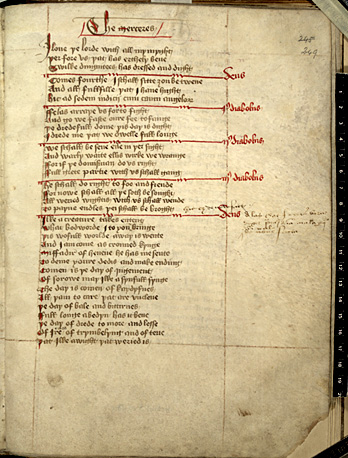
This is a page from a play text, the collection of pageants from the York Corpus Christi Play, which we know nowadays as the York Cycle of mystery plays.
It is an official civic document, the Register against which the Common Clerk (York's Town Clerk) or his Deputy checked the text of the play as it was being performed each year, to make sure that the actors were word-perfect (otherwise their guild could be fined), and that nothing new had been inserted that was contrary to the Christian Faith. It was the job of the Clerk to update the Register from the guilds' originals (individual play texts), and on this page you can see the marginal notes made by John Clerke in the 1530s reminding himself to do just that.
Because it is an official document, an effort has been made to present it neatly. It is not, however, a luxury presentation copy.

The layout is basic. The scribe has frame-ruled an area of the page to contain his text block, but has not pricked and ruled individual lines. The ruling is more trapezoid than rectangular: but since it is echoed on the other side of the folio, the show-through remains inside the text area.
Nonetheless, he has kept his line of writing straight and the size of script is regular.
 |
The space between the written lines is larger than the space between head-line and base-line in the proportion 3:2. |
 |
Because the ascenders and descenders are so long, they sometimes clash: but on the whole the lines look well-separated. |
The margins are ample: possibly to allow room for corrections and annotations.
There is a running title at the head of each page, giving the name of the guild to which the play belongs. Here it is the Mercers' play of Doomsday.

Scribes were only just beginning to evolve a technique for presenting plays, and some of the conventions are markedly different from those of the present day.
Speeches are separated from each other by decorative horizontal lines in red, terminating in speech headings, which are placed in the right margin, not the left as nowadays.

The characters' names are in Latin. This one is Secundus Diabolus, 'Second Devil'.
Because the play is in verse, the text is left-justified only. It follows the conventions developed for the layout of other literature in verse.
| These capitals are sometimes larger forms of the lower-case letters, |  |
 | |
| sometimes separate Secretary forms. |  |
 |

|
| One particularly interesting form is the use of double f for capital F. This appears even in the body of the text, when the God the Son speaks of 'My Father of Heaven' in line 23. |  |
 |
|

but sometimes it appears to mark a dramatic pause elsewhere in the line, as after the word comen in the third line here. You may notice that there is no mark in the middle of the last line at all. The strokes here are highlighted in red.

There is a slight complication. You may remember from last week that the head-stroke of the letter t ended in a downwards flick. This is also a feature of this scribe's hand, and it is sometimes difficult to tell whether this downstroke is meant to be a punctuation mark or merely a calligraphic ornament. He does the same with the cross-stroke on double l, and apparently with the head-stroke on g.
 |
|
|
 |
|
|
Return to Question Page.
Return to Index Page.
© MEG TWYCROSS 2000